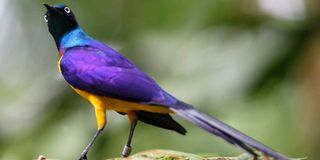‘Dim the lights for birds at night’ , enthusiasts say as they mark day

The Golden-breasted Starling.
Every second Saturday of May, bird enthusiasts mark the World Migratory Bird Day. Yesterday was no exception.
Among those who were out sighting and observing various bird species is Mr Ben Akatch, the mobile education officer at the Wildlife Clubs of Kenya.
“The day gives us an opportunity to educate the world about the protection and preservation of over 9,800 bird species in the world. About 40 per cent of these birds are endangered,” said Mr Akatch, who was bird-watching with fellow club members at Olchoro Onyori Primary school in Kajiado County.
Yesterday was also a day to reflect on how Kenya has been treating migratory birds. In January, a white stork, tagged in Poland, flew over 7,000 kilometres only to be electrocuted to death in Nandi.
In another occurrence, a lucky osprey that had travelled for over 6,000 kilometres was caught in a fishing net in Siaya while hunting. It was later rescued by KWS and rehabilitated at the Raptor Rehabilitation Trust in Nairobi.
Migratory birds travel thousands of kilometres in search of favourable weather, feeding or breeding conditions. Some birds travel shorter distances than others, such as the greater and lesser flamingo species found in Kenya that move from one alkaline lake to another along the Great Rift Valley from April to June every year.
Migratory routes
Scientists are able to keep tabs on a bird’s movement by tagging it with a band that would show where it was last spotted. The metal or plastic band informs people of the bird’s migratory routes which may indicate where it previously flew from.
The theme of this year’s celebration is “Dim the lights for birds at night”, aimed at creating awareness about the dangers of light pollution to migratory birds.
In a press statement released ahead of the World Migratory Bird Day, the United Nations Environment Programme (UNEP) said that light pollution contributes to the death of millions of birds every year. It alters the natural patterns of light and dark in ecosystems, which can change birds' migration patterns, foraging behaviours, and vocal communication.
Attracted by artificial light at night, particularly when there is low cloud, fog, rain or when flying at lower altitudes, migrating birds become disorientated and may end up circling in illuminated areas. Depleted energy reserves put them at risk of exhaustion, predation, and fatal collision with buildings.
Bird enthusiast Joseph Aengwo, who was looking forward to yesterday, said he started earning a living at 14 because of his self-taught knowledge on birds. His curiosity was sparked by tourists who would take evening walks with binoculars looking for birdlife on the lakeshore at Lake Baringo Country Club as he took care of his family’s livestock.
He is now an ornithologist, a bird expert, who has been one of the observers that have put Kenya on the map every Global Big Day — another name for the World Migratory Bird Day.
Karura Forest
The day is also the first phase of a bi-annual census conducted worldwide in May and October through which anyone can be a citizen scientist. Bird watching could be as simple as spotting and identifying the birdlife that land on your windowpane at home or as you take a stroll in the Nairobi Arboretum or Karura Forest.
“This year, I will be observing from Nairobi National Park. It is a great way to encourage people to conserve and observe nature. Everyone can contribute to building the global database for bird species by becoming a citizen scientist,” Mr Aengwo told the Sunday Nation last week. This is his fourth year taking part in the exercise.
To participate in identifying birds, one must have an eBird account to log in the details of those they see or hear, where and when they were sighted.
The observations help scientists understand global bird populations and trends better since it is not possible for them to collect data from all over the world at the same time. Identification tools such as an app called Merlin are available resources that can be used to correctly name sighted birds.
In 2006, the first celebration of the World Migratory Bird Day took place in Kenya, organised by Kuki and Sveva Gallmann in partnership with the United Nations Environment Programme, the Convention for Migratory Species (CMS) and the African-Eurasian Waterbird Agreement (Aewa) at Ol Ari Nyiro which was designated as an important bird area by Birdlife International and Nature Kenya.





